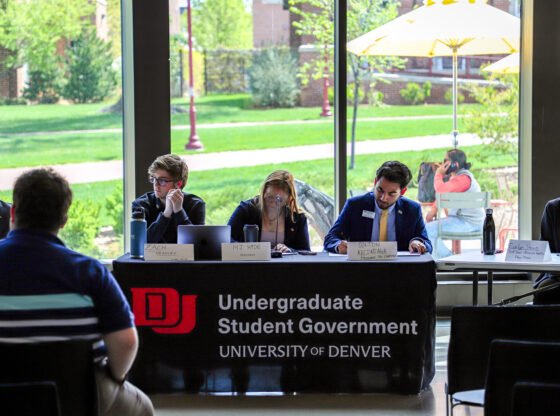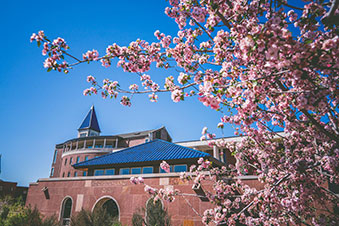Changing application processes and student interest in recent years opened the university this year to its highest ever enrollment class, leaving university departments working to adjust to the change.
According to Emily Forbes, director of communication for DU’s enrollment division, the university received almost 20,000 student applications last year, admitting 10,500 of those applicants. This year 1,413 of those students enrolled at DU, making the class of 2017 the largest incoming class in DU history.
The increase comes as part of an administrative decision last spring to accept more students in 2013 in an effort to maintain university enrollment at about 5,000 undergraduate students, according to Forbes.
“With the number of advanced placement and international baccalaureate credits students were bringing in and a higher number of our students graduating in four years or less, we needed to ensure we were balancing the overall student population,” said Forbes.
This has led to an increase from 1,214 enrolled students in the fall of 2012, a year in which DU accepted 7,159 applicants.
“For the past several years the target enrollment for incoming first year students has been around 1,200,” said Forbes. “This was the first year that we had a more significant increase.”
According to Forbes, easier and more streamlined application processes at schools nationwide have allowed students to apply to more schools than before, meaning they have more options when choosing where to attend.
“This trend in many ways has made it more challenging for admission offices around the country to use historical data to predict yield. Instead of relying on one out of every three students admitted, for example, schools now may need to admit more students knowing that only one out of every five may actually enroll, since each student is considering more options,” she said.
The larger class size, however, means adjustments must be made throughout campus departments.
This year the Media, Film and Journalism Studies (MFJS) department has seen a significant increase in students declaring media majors, according to Derigan Silver, director of undergraduate studies for the department.
Though the official number of MFJS majors has not yet been officially determined, Silver estimates it is at approximately 215 students. Silver said similar increases have been seen across many Arts, Humanities and Social Sciences (AHSS) majors.
A representative of AHSS was not available to comment at the time this article went to print.
The increased numbers have led to several departmental changes in order to support the increasing number of students within MFJS.
“We’ve increased our class size in some of our introductory level classes, but we’re really trying to minimize the impact on classes where our students need a lot of individual or close attention,” said Silver. “We are still keeping those class sizes where they were.”
Though writing-intensive classes within MFJS have stayed the same size, some of the larger introductory classes have risen from 35 students to 40 students.
“We have really great professors teaching those classes who will allow a couple of students in, so going from 15 to 20 students in a class is a big difference, but going from 35 to 40, or even 35 to 45, is not really that huge of a difference,” said Silver. “I’d much rather have a class of 30 go to 40 than I would have a class of 15 go to 20.”
Both Forbes and Silver pointed to last year’s presidential debate, which was held on campus in October 2012, and subsequent attention to the university as one reason for the increase in applications. Forbes said the university has also introduced outreach earlier in students’ careers, as well as expanded it internationally to reach more students.
Silver sees the increase in students as having both good and bad effects.
“You do want DU to become successful, you do want DU to become better known, you do want the caliber of student who applies to DU and is accepted to DU to get better, but it definitely leaves you scrambling in some situations,” he said. “FSEMs have increased in size this year from 15 to 20 [students] and that’s definitely an impact we felt in this department and they felt across the university.”
The department of Housing and Residential Education (HRE) is another department which has had to compensate for the increasing number of students in the system; this year they added four floors in Centennial Towers that were reserved as single rooms last year and moved to double person rooms this year.
“I would say it’s around 50 students that the occupancy increased in Towers,” said Demitrius Brown, executive director of HRE. “That is well within what the building can contain. We’re not crowding people in by any means.”
As the freshman class continues to move through the university, departments are expecting further adjustments to be made to continue to support the higher number of students.
For Brown, that means making some changes to the application process for housing in second year residence halls, Nelson and Nagel, after the housing selection process last year was held up by long lines as students waited to select their accommodations for the next year. He is beginning to plan how the system will change this year to better accommodate large numbers of students.
“It’s still very early for us in deciding what that process is going to look like,” he said.
However, he said second year students would still primarily be housed in Nelson, Nagel and Centennial Towers.
Though this year qualifies as the largest freshman class in DU history, Silver and Forbes said not to expect the same numbers to be admitted to DU again in 2014. According to Forbes, the university is looking to recruit approximately 1,425 students this year.
“There’s really not many plans to make DU an overall bigger place than it is now,” said Silver. “We had a large number of students apply and then we accepted them, and there’s always a difference between the number you accept and the number that you actually enroll. This year not only did we accept more students, a larger portion of those students actually enrolled, which is kind of a good thing and a bad thing.”











